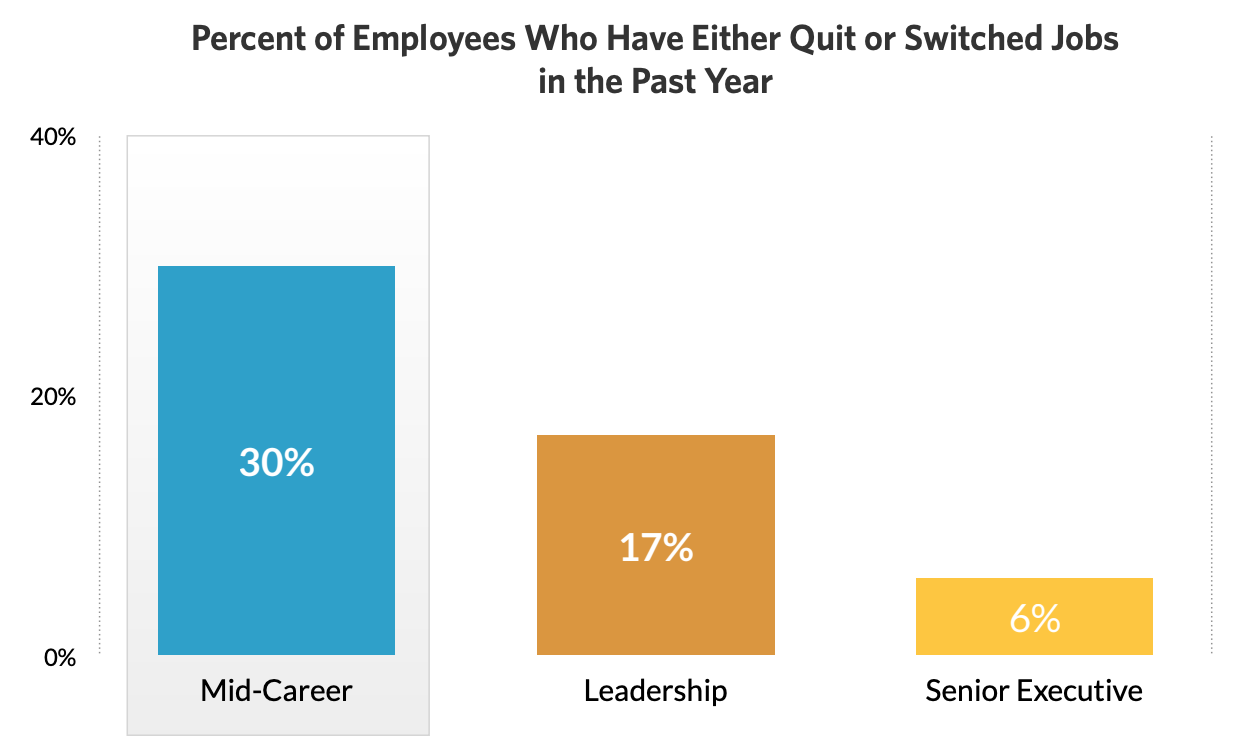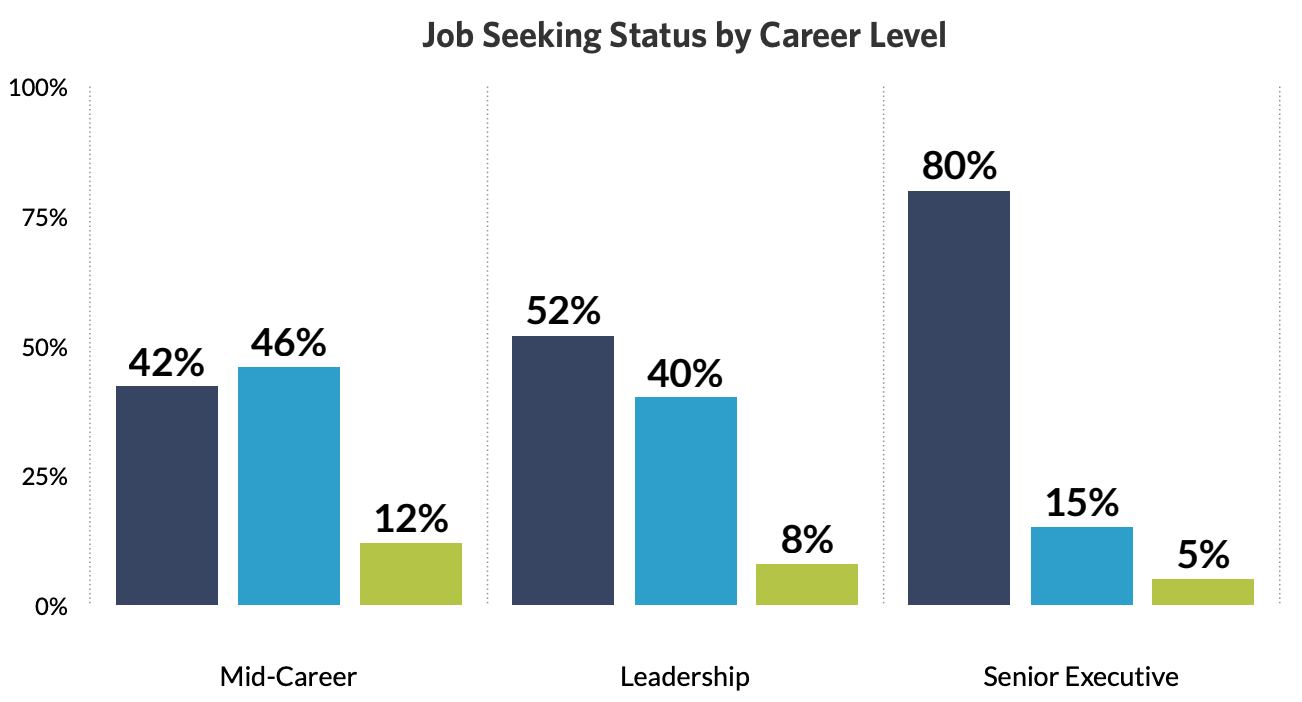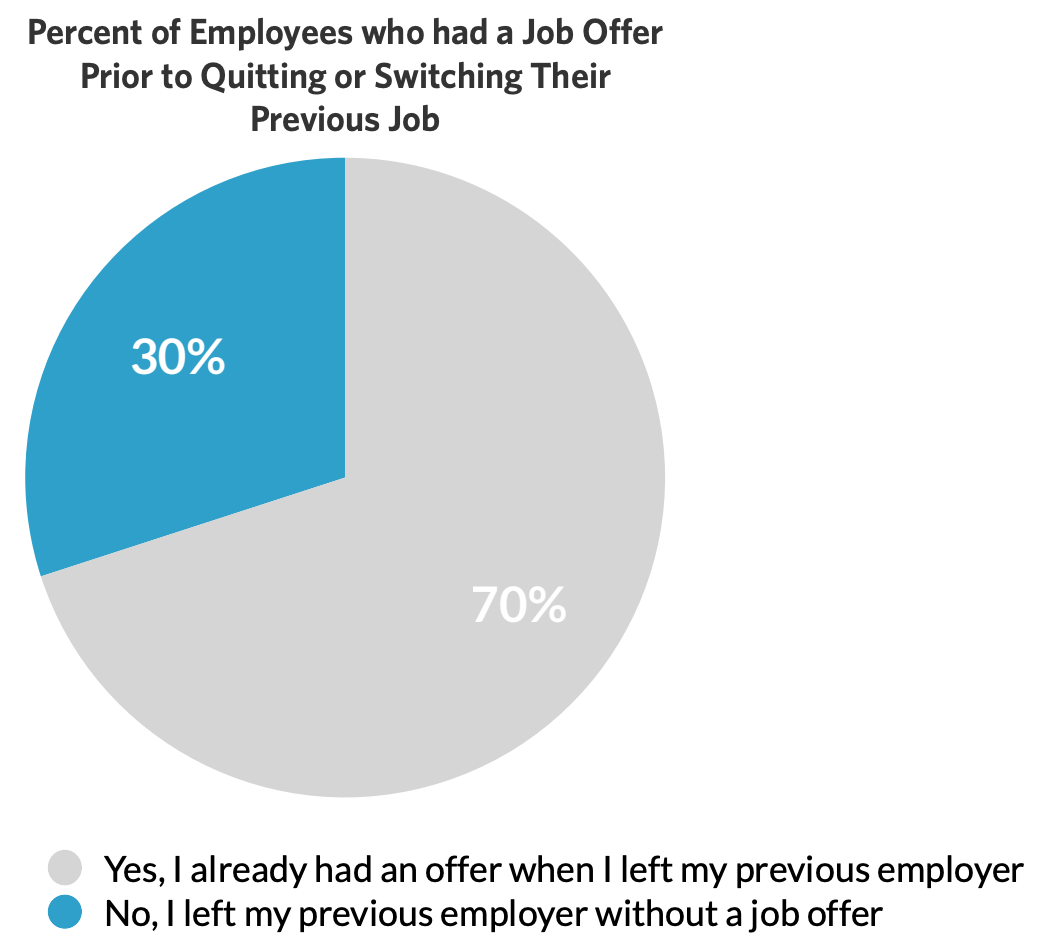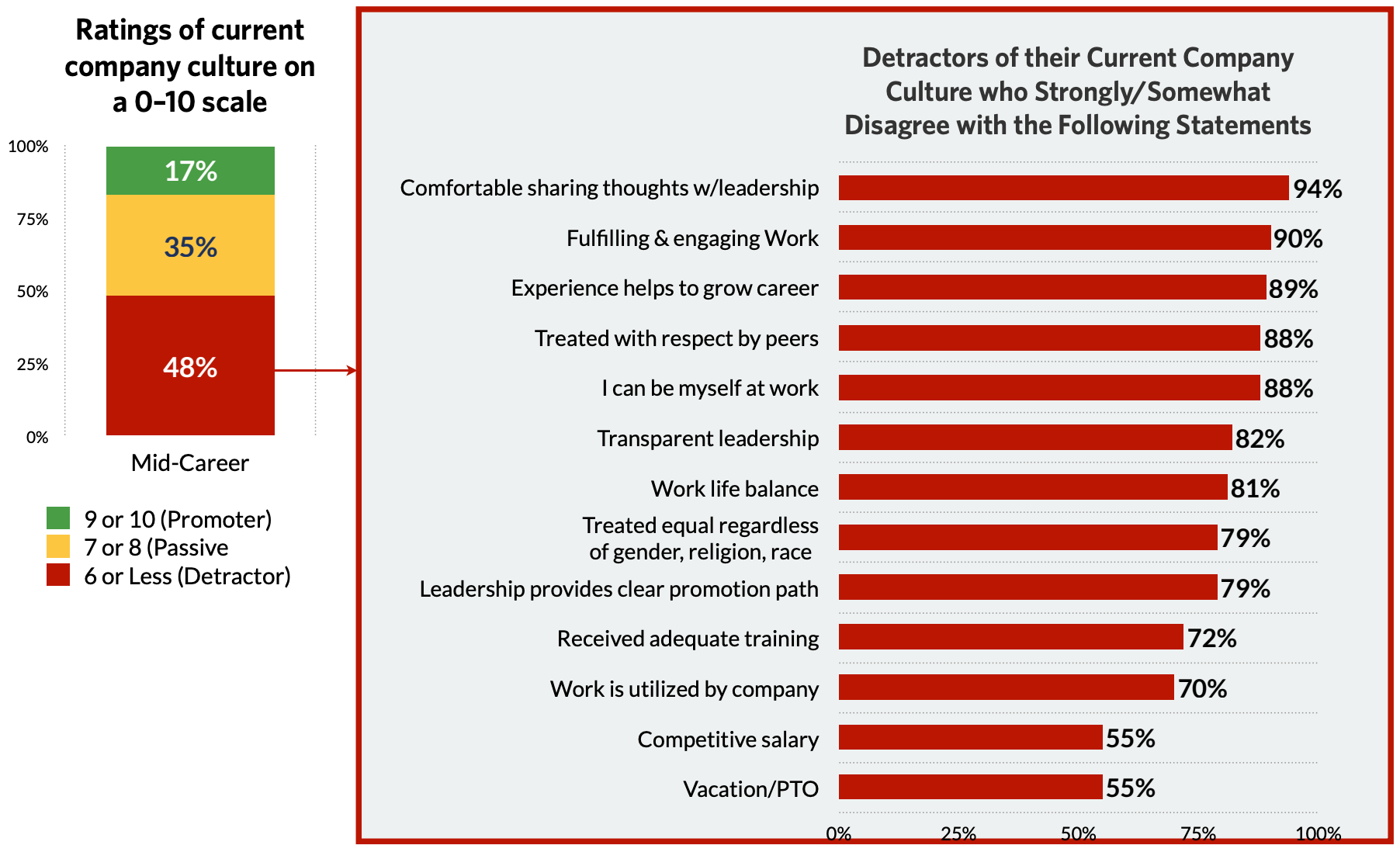We have all seen⏤or at least heard of⏤the “Mid-Life Crisis.” Typically, there is an abrupt change in behavior in someone who is middle-aged. That behavior may cause some to abandon responsibilities in lieu of more fun, rewards, or satisfaction.
But were you aware of the rapidly growing “Mid-Career Crisis”? Typically, there is an abrupt change in behavior in someone who is in mid-career. That behavior may cause some to abandon responsibilities in lieu of more fun, rewards, or satisfaction.
Contrary to public belief, the mid-career employee segment, not the entry- or junior-level employee segment, is the largest group leaving jobs today. They are leading the disruption in the Great Resignation trend. While more than six million employees quit their jobs in February 2022, 20% of them were mid-career employees. According to a new research study from the Hinge Research Institute entitled, Navigating The Mid-Career Talent Crisis ⏤ A Report For The Professional Services, that percentage rises to 30% when you look at those surveyed who quit or switched jobs in the past year.

About The New Research Study
The Navigating The Mid-Career Talent Crisis research surveyed more than 284 professionals currently working in the professional services industry. Mid-Career employees accounted for 91 of those survey responses. The research participants completed an online survey that included both quantitative and qualitative questions. The research was produced by the Hinge Research Institute and is available at no cost.
Who Are The Mid-Career Employees?
The mid-career employees were those with titles of manager, senior manager, project lead/manager, or something equivalent. Their ages ranged from 30 years old to 45 years old. The leadership employee segment included those with titles of director, senior director, partner, or vice president. The senior executive employee segment included the titles of CXO, president, managing partner, founder, or principal.
Why Are Mid-Career Professionals Leading This Trend?
For years, corporations, firms, associations, and other organizations have relied on the mid-career staff to solve problems and move things forward. Mid-career team members were in the precarious position of accepting and being held accountable for leadership and senior management’s strategies and goals⏤while also being responsible for ensuring that their staffs achieved those objectives.
On top of that, those in their mid-careers are the ones who assume the burden of creating an environment that is supportive, fun, visionary, purpose-driven, and more. Unfortunately, with all the unstable health, social, economic, and political conditions arising in these times, mid-career staffs are tired and stressed…making them more sensitive to the challenges of their employment situations, other opportunities, and life priorities. In our research, less than half of mid-career employees were satisfied at their job.

In fact, for some, frustration or the desire to change circumstances are so strong that they are prompting mid-career professionals (30%) to quit their jobs without having another job offer.

What Is Driving Dissatisfaction?
There are two reasons that stand out above all the rest as the reasons why mid-career employees quit their jobs: 1) Frustration with leadership/management (75.9%) and 2) Desire for a better company culture (72.4%). These two reasons ranked higher than “wanting a higher salary” at 44.8%, “unable to get a promotion” at 31%, or any other reason.
Now is the time to conduct employee research or surveys to collect more input around your company culture and suggestions on how to improve it. It may also be the time to invest in leadership assessment and training. Keep in mind, a lot of folks rise to leadership positions because of their performance and accomplishments⏤not because they have great communications or management skills.

Diving deeper into leadership issues, those mid-career employees that gave their company culture a low rating (6 or less) did not feel comfortable sharing thoughts with their leadership (94%), did not see transparent leadership (82%), and did not feel that their leadership provided clear promotional paths (79%). These are large percentage numbers concerning leadership and should be addressed if you want to navigate through the mid-career talent crisis. Start by running a survey within your organization to see if you get similar results or if other leadership concerns arise.

So, The Crisis Has Been Identified, How Can You Minimize It?
To start with, be pro-active but don’t overreact. Address it in stages or phases. The more information and feedback you can collect, the more you will be in a position to plan, prepare, and respond. Keep in mind that there are three disruptive components of this trend:
- Employees that you have invested in and rely on may leave with little to no notice⏤impacting deadlines, dependencies, and deliverables
- These departing employees may get other employees to think about leaving
- Backfilling these open positions may take a long time or may not happen at all
The key to minimizing the Mid-Career Crisis is to effect change before your mid-crisis professionals reach “the point of no return.” If they can see that they are being heard and changes are being made, they may not reach the snapping point and maybe you can get them to de-escalate from the active seeker stage to the passive seeker stage to eventually the satisfied employee stage. A lot of the triggers for mid-career staff departure are focused around not being respected, heard, challenged, or appreciated.
One of the best and fastest ways to improve company culture and create an environment of hearing and appreciation is by having in-person, work-related social events on a regular basis. The face-to-face corporate happy hour is back! It’s true. This was highest ranked service or program recommended by mid-career professionals at 43.1%. Keep in mind that these events must be in-person. Virtual social events ranked lowest on the list of recommendations at 4.2%. Perhaps it is because this employee segment in particular has to interact with so many other employee segments that they are tired of the daily virtual meetings. They want to get back to the days when they can forget or laugh about their issues with others who understand their issues over a mixed drink, pint of beer, or glass of wine.

Another fast way to improve company culture is to provide a mental health day. Make it a floating holiday. This is a tangible and meaningful way to show employees, especially mid-career professionals, that they are valued and appreciated. Mental health days ranked second at programs that could help improve company culture by mid-career staff. When looking at the responses of the three employee segments that we researched, mid-career professionals valued mental health days significantly more at 36.1% than did Leadership (18.5%) and Senior Executives (8.8%).

Where Are Prospective New Hires Learning About Your Company Culture?
Despite your best efforts, several mid-career employees have left your company and now you must replace them. Since corporate culture is such an important consideration for many of your mid-career job prospects and candidates, where do you need to make sure your corporate culture is clearly conveyed and showcased? The top answer according to our research is your website. “Looking at the company website” (79.8%) ranked higher than “social media” (60.7%), “Glassdoor reviews” (58.3%), “online search for articles about the firm” (50%), or “discussing culture with interview participants” (29.8%).

So, how does your corporate culture come across on your website today? Step back and assess. Does your culture come across as inviting, caring, purpose-driven, respectful, team-oriented, and more? Are their webpages that could be tightened up or reformatted to tell a better and clearer story. Could the navigation be improved for a better journey? Are there components you could add to your website so that visitors stay on your website longer? A lot of first and last impressions are made from a website visit. Make sure you have done everything you can to make sure that prospective candidates want to interview with your company.
Next Steps
While this article does not cover all the findings in the Navigating The Mid-Career Talent Crisis research study, it does provide a strong foundation for you to begin listening and adapting to the concerns of your mid-career employees. Here are three steps to follow:
- Realize that many of your mid-career staff will consider leaving this year. It is a fact. It has been happening month after month. Even those who are satisfied with their corporate culture are being tempted. Now is the time to roll out a phased retention plan that may include training, improved communications processes, in-person social events, and more. Show your mid-career team that you are listening and appreciate them.
- Don’t underestimate mental health days or DEI programs. As we mentioned earlier, mid-career professionals are more stressed than ever. When asked about programs that help improve company culture, “Mental health days” ranked at the top. Diversity, Equity, and Inclusion (DEI) programs ranked second (26%) on the list of programs that mid-career staff see as improving company culture.
- Re-assess the messaging of your website. The focus on corporate culture is stronger than ever and your website is the highest ranked location that job prospects access to learn about an organization’s culture. How does your culture come across? Ask friends and family members to visit your website and give you their impressions. Nowadays, there are so many techniques you can use to make your culture stand out on your website. Be sure your website is a high-performance website.
There is a lot to take in with this new research study. Your organization may not be feeling the negative impact of the Mid-Career Crisis yet. That is great. You have not felt the disruptions to business and you have time to adjust and plan for it. Too often we find ourselves in situations where we say, “I wish I had known about it” or “I wish I had more time to prepare for it.” Make the most of this opportunity. Download the free research study today and learn more about mid-career professionals including how they search for new jobs. And remember, you don’t have to do all of this on your own. Hinge can provide expertise to help you with your website, research, or content needs.
Additional Resources
Download the full research report, Navigating the Mid-Career Talent Crisis: A Report for the Professional Services, for more powerful insights.

